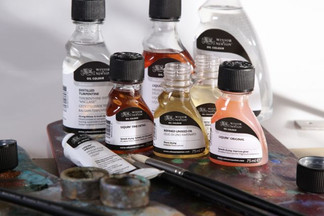Varnishing Oil Paintings | Types, Benefits & Best Practices - Part 2 of 4
- Artzo India
- Mar 22, 2023
- 3 min read
Updated: Apr 19, 2023
In part 2 of our 4 part series, we explore the types, benefits & best practices of varnishing oil paintings. Read on to learn and explore.

Varnishes are a popular addition to oil paintings as they can enhance the overall look and longevity of the artwork. If you’re an artist who uses oil paints, understanding varnishes and their benefits can help you make better decisions about how to protect and present your work. In this blog post, we’ll explore everything you need to know about varnishes for oil paintings.
What is an Oil Painting Varnish?
A varnish is a protective coating that is applied over a finished painting to protect the surface from environmental factors like dust, dirt, UV light, and moisture. Varnishes can also enhance the color and saturation of oil paints, giving them a more lustrous and appealing finish.
There are two main types of varnishes for oil paintings: Solvent-based and Water-based. Solvent-based varnishes are typically made from natural resins, such as dammar or mastic, that are dissolved in a solvent like turpentine or mineral spirits. Water-based varnishes, on the other hand, are made from acrylic polymers and are thinned with water.
Benefits of Varnishing Oil Paintings
One of the main benefits of varnishing oil paintings is that it provides protection against environmental factors that can cause damage over time. This includes dust and dirt, which can accumulate on the surface of a painting and cause discoloration and deterioration. Varnishes can also protect against moisture, which can cause cracking or warping of the paint over time.
Another benefit of varnishing is that it can enhance the colors and saturation of oil paints, giving them a more vibrant and glossy appearance.
This is especially true for darker colors, which can appear more opaque and rich when a varnish is applied.
Choosing the Right Varnish
When choosing a varnish for your oil painting, there are several factors to consider. One of the most important is the level of gloss you want to achieve. Varnishes come in a range of gloss levels, from matte to high gloss, and each will affect the final appearance of your painting.

Another factor to consider is the type of varnish you want to use. Solvent-based varnishes tend to be more traditional and are often favored by artists for their lustrous finish. However, they can yellow over time and may require additional layers of varnish to maintain their appearance. Water-based varnishes, on the other hand, are less likely to yellow and may be easier to apply, but they may not provide the same level of gloss or depth as solvent-based varnishes.
Applying Varnish
When applying varnish to an oil painting, it’s important to prepare the surface beforehand.
This may involve cleaning the painting to remove any dust or debris, as well as allowing the paint to dry fully before applying the varnish. It’s also important to ensure that the painting is completely level, as any drips or unevenness in the varnish can be difficult to correct.
When applying the varnish, it’s best to use a soft-bristled brush and to work slowly and carefully to avoid any bubbles or drips. It may be necessary to apply multiple layers of varnish to achieve the desired level of protection and gloss.
Conclusion
Varnishes can be a valuable addition to oil paintings, providing protection against environmental factors and enhancing the overall appearance of the artwork. When choosing a varnish, it’s important to consider factors like gloss level and type of varnish, and to apply it carefully and methodically to achieve the best results. With the right varnish and application technique, you can help ensure that your oil paintings look their best for years to come. Shop for Oil Paints here. Shop For Varnishes For Oil Paints here. Also Read: Varnishing Series Introduction Varnishing Watercolour Paintings Varnishing Acrylic Paintings
Source Credits: Jackson's Art | Winsor & Newton | Gamblin










Comments